Don't wanna be here? Send us removal request.
Text
MFA Media Design

Month 1: Personal Development and Leadership
It has been three It has been almost 5 years since I took this course, I can not recall exactly what the course was about. I do know that in this course we started to map out our objectives for the Media Design Masters program and reflected on how we as students can can have a better understanding of design and the creative industry. This course helped me develop a better understanding on how to promote and brand on a personal level.
Month 2: Defining Client Needs
This course has helped me understand that, good design is all about knowing the client and their needs. This course has helped me complete my thesis project by allowing me to have a better understanding of the clients design problems and how find solutions to those problems that match the client’s values.
Month 3: Brand Development
This course allowed me to understand process of brand development, and how important it is to understand the client through research. Research is key to developing a brand and differentiating the brand from its competitors. This course help with the completion of my thesis project by giving me a better understanding on how research is crucial to brand development and finding unique factors that will differentiate from the market place competitors.
Month 4: Effective Copy writing
This course showed me how important copy writing is to good design. Copy writing is as much apart of the design process as the design itself. This course helped with my thesis project by expanding my knowledge of design layout, compositions, typography, and hierarchy.
Month 5: Design Research
This course was all about place branding and research. I learned how important primary and secondary research is to finding unique and compelling factors to differentiate from the client’s competitors. This course helped with me complete my thesis project by instilling the importance of research is to establishing a new brand.
Month 6: Organizational Structures
This course was all about motion design and how to use motion design to tell stories. This course taught me that telling stories the difference between good motion design and bad motion design. This course helped me with my thesis project by helping me understand that telling stories can be obtained in all design. I used this philosophy when working on my Box Park Sushi brand. I tried to tell a unique story that would help reflect the overall brand values and unique factors that differentiate the brand from the competition.
Month 7: Design Strategies & Motivation
This course taught me how to conduct research by using demographic information to find out who the right target audience is for a given demographic in a specific region. This course helped me develop the branding for the Box Park Sushi brand project which was featured in the thesis project.
Month 8: Design Integration
This course showed me how the overall design of the brand fits together. The brand design was shown by developing a vision board which showed the vision of the brands design and how it works with the overall concept of the branding efforts. The brand design brief is a document used to present to not only the client but the creative team on the overall vision of the brand.
Month 9: Multi-Platform Delivery
This was all about finishing up the Box Park Sushi brand design and develop and brand guide to help the client and the designers use the assets for the brand that maintains a consistent brand messaging to the target audience.
Month 10: Measuring Design Effectiveness
This course was all about showing how important it is to conduct survey’s on how well the design of a brand is performing and if the target audience is being reached with the proper brand messaging. We conducted the surveys and showcased the results in the form of an info-graphic.
Month 11: Thesis Presentation of Design Solution
This course had use present our mastery of Direct Learning Outcomes by developing a website. While developing the website the same design philosophies used for print, and motion were utilized. We showcased a project for each DLO that showed how we mastered and understood that particular DLO.
0 notes
Text
Presentation of Design Solution
This month was all about revealing and proving how the chosen design solutions meet the direct learning outcomes of this program. This course has a direct connection to occupational design work in the way that when solving design problems for a client. A designer needs to not only conduct appropriate research and explore many possible design solutions, but find the solution that is the best choice for the client. The designer needs to present and prove that this solution is the best way forward to the design team, and then the client. By showing the research conducted and the work that was done to reach the final design, it tells a story about the process used for the discovery of the final design and why other options explored does not work for what the client needs.

Developing website by first creating page layout sketches and wire frames was another way to show how important it is to explore multiple design solutions. The peer reviews was an excellent way to show how to conduct proper and professional critiques of students or colleagues work but also how to receive critiques and feedback from them as well. This is important, because has a designer, we do not see everything, and may miss small details that can make a good design a great design.

The website we built this month was to show how our design solutions meet the direct learning outcomes from this program. It is also a great example how we as designers can put together a web page or a design document in similar fashion to use as a presentation to show either a creative director or marketing team or the client on the best solution for the clients design problems. It is also a great way for freelance designers or studio to show potential clients their process and work. Many studio or freelance designers will show their work in the form of case studies, which is very similar to what we did in this months course. The biggest takeaway from this month, is that it is very important to document the creative process and to show the process and the research involved with this process to help show the client that the final design solution is the best route to take for their design problem.
0 notes
Text
Measuring Design Effectiveness
Connecting/Synthesizing/Transforming
This month was all about determining if and how a design is communicating to the target audience, and how effective the overall messaging is. First we must determine the brands values that the target audience is receiving from the brand. According to Ken and Jenn O'Grady, a brand's value is separated into two categories. These categories are hard values and soft values. Hard Values are concrete and tangible things that can be easily measured. Examples of hard values include: increase in sales, expand participation, enhance user ability, saves time, drives online traffic, and cuts waste and saves material. A design that encourages the audience to click a link on a website or visit a brand store is a hard value. Soft Values are intangible, subjective, and are harder to measure, according to Ken and Jenn O'Grady. Soft values are values that evoke emotion, creates connections, and fosters trust between a brand and the target audience. Examples of soft values include: creating loyalty, delight and inspire, empower action, and build understanding. Most brands will have a combination of both hard and soft values in their communication. Measuring the effectiveness of the brand can be accomplished by conducting surveys and questionnaires.
From a designer's perspective, it is important to know that the design is communicating the brand's voice and tone to the target audience. Writing questions to ask the target audience can help get vital information on what is working with the design, along with areas of the design that needs additional work. Surveys can also help determine if the brand is different enough from its competitors. In an article by Josh Braaten, he states that "89 percent of companies are using customer experience as a way to differentiate and compete" (Braaten, 2019).
Once the data from the surveys and or questionnaires are collected, we can then determine the effective of the overall communication from brand. We can take this information and make it easier for the audience who will see this data to understand the data that was collected. Data Visualization, Information Design, and Editorial Infographics all are infographics for their own purposes. All three can be great at communicating with the intended audiences by telling stories. According to Josh Ritchie, Data Visualization Infographics are a visual representation of data. Information Design Infographics are is graphic design that focuses on the display of information. Editorial Infographics are used in editorial publications to catch the eye of the reader and maintain their attention by using compelling graphics to tell a visual story.
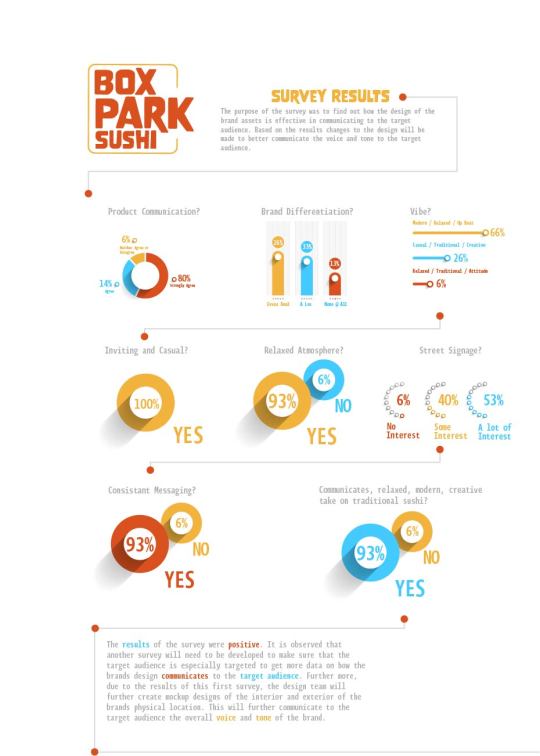
Problem Solving
The biggest problem that had to be solved this month was conducting the survey. The lack of survey participants was due to the lack of social media from the designer. There was also a lack of media assets that would of help solidify the brands overall communication to the target audience. These problems did not get solved during this course. If this was an actual client then the solution to the problem would be to utilize the brands social media to reach out to the audience and get more participants for the survey. Along with that, show designs of the exterior and interior of the restaurants space to show the audience taking the survey a better visual representation of the overall voice and tone of the brand.
Innovative Thinking
The work conducted this month was inline with others in the industry. Not a whole lot of innovative thinking was conducted this month. The biggest design challenge this month was determining the design of the infographic. Designing the infographics so that they match the brands messaging was the only challenge this month.
Acquiring Competencies
Competencies acquired this month was discovering hard and soft values and how these are important with understanding how these values are being communicated to the target audience. (Conceptual, Occupational)
How surveys and questionnaires are conducted and the difference between the two. (Conceptual, Occupational)
Infographics and the different types of categories they contain. The main three categories are Data Visualization, Information Design, and Editorial Infographics. (Conceptual, Occupational)
Braaten, J (2018, April 19) 3 Brand Perception Survey Questions That Reveal Voice of Customer [Online Article] Retrieved from https://surveyanyplace.com/brand-perception-survey-questions/
Ritchie, J (2020) What is an Infographic? What They Are and Why they're Useful [Online Blog] Retrieved from https://www.columnfivemedia.com/infographic
O'Grady, J; O'Grady, K (2009) A Designer's Research Manual [Online book] Retrieved from https://learning.oreilly.com/library/view/a-designers-research/9781592535576/chapter-16.html
0 notes
Text
Multi-Platform Delivery
Connecting/Synthesizing/Transforming
This month was all about logo design and creating and designing media assets for the Box Park Sushi rebranding project. When it comes to design, whether it be a logo or a design layout, sketching is the first step that every designer should start. Henna Ray says, "Every designer has a different creative process. Sketching is, however, a common habit with most of the designers. You can instantly sketch many ideas roughly on a piece of paper" (2019, para. 3). The important thing is being able to get ideas on paper so that a designer can weed out the good ideas from the bad. When developing a logo, David Airey says "Simplicity helps a design be more versatile. Adopting a minimalist approach enables your logo to be used across a wide range of media, such as on business cards, billboards, pin badges, or even a website favicon" (2015). Some of the most iconic logos are very simplistic, examples are FedEx, Nike, and Apple. David also suggests limiting the amount of time a designer spends on one concept sketch. A designer should be loose and just let the ideas fly keeping the sketches appropriate for the brand. Taking these lessons learned and applying them to this month's projects helped in the development of the Box Park Sushi logo design.


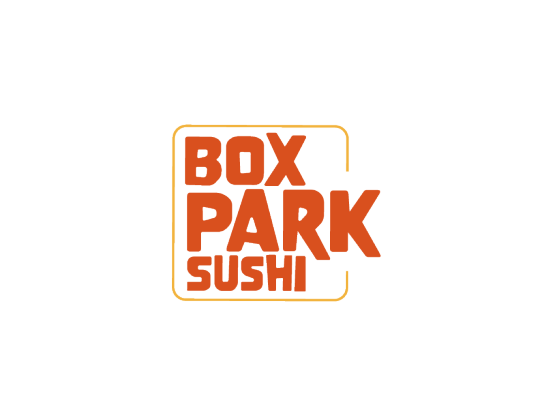




Whether a designer is working as a freelancer or at an Agency or studio, project management is essential. Staying organized and managing the timeline of a project is key to meeting deadlines and successfully meeting project goals for the clients. In an article by workerbee, they give some helpful tips on how to project and time management on a budget along with highlighting tools that can help freelance designers. Having first-hand experience in the creative industry, project, and time management is crucial for not only meeting client deadlines, but also communication within a team. Even professional studios and agencies get this wrong, and it makes for a stressful work environment. This month we had to manage our own time and determine the milestones for the development of the media assets by the due date.
Creative Briefs are essential to design project communication to the client and the creative team. Creative briefs act as a universal language that all parties involved can understand, eliminating confusion. The creative brief contains expectations from the client, measure and defines success, used as a guide during the decision-making process, and evaluate design solutions to the client's problems. Developing an excellent creative brief can build trust between the client and the creative team, allowing for more natural communication and creative solutions to be presented.
Problem Solving
The design problem this month was the development of the logo. Developing a logo that communicated the brand’s messaging while being simplistic and recognizable was a challenge. Some of the most iconic logos are really simple. To achieve simplicity while visually looking like the logo belonged to the Box Park brand. The logo design process was used to get the final results. Starting with sketches and then picking three to showcase to classmates. Classmates then reviewed our selections and critiqued each logo and picking the strongest out of the three. This process really helped in the development. The final logo presented fits the brand very well. It is simplistic, represents the Box Park Mall along with Box Park Sushi and maintains the overall messaging and attitude of the brand.
Innovative Thinking
The design of the logo and media assets produced this month was not that innovative. The innovation is in the overall rebranding and image of Box Park Sushi and how it is a New Take On Tradition. Thinking about the majority of Sushi restaurants in America, most of them are fairly fancy and have somewhat of a mood to them. The branding of Box Park Sushi is going in the opposite direction and is pursuing a more modern, hip take on the sushi tradition. The vision is to have a sushi restaurant that has a relaxing and chill atmosphere, where anyone can come in for lunch or dinner, and not have to make it into a big event.
Acquiring Competencies
This month was a great month to learn new concepts and procedures in the design process. The biggest takeaways and lessons learned from this month was conducting post-mortems every time after each project. (Occupational, Conceptual) The next takeaway from this month is how to create and design a brand style guide. (Occupational, Conceptual) The next is the process of developing a simplistic and memorable logo. (Occupational, Conceptual) The last takeaway from this month is that all the best ideas, need process, structure and discipline. (Occupational, Conceptual).
Airey, D. (2015). Logo design love, annotated and expanded. edition, second edition. Retrieved from https://learning.oreilly.com/library/view/logo-design-love/9780133812589/ch03.html
Chan, S (2019) How to Create a Brand Style Guide [Online Article] Retrieved from https://99designs.com/blog/logo-branding/how-to-create-a-brand-style-guide/
Fanguy, W (2018, May 17) Running a Successful Post-Mortem [Online Article] Retrieved from https://www.invisionapp.com/inside-design/running-successful-post-mortem/
Ray, H (2019, March 10) How To Proceed With Sketching Of Logo Design [Online Article] Retrieved fromhttps://www.designhill.com/design-blog/how-to-proceed-with-sketching-of-logo-design/
Workerbee (2019) How to Optimize Your Workflow as Freelance Graphic Designer [Online Article] Retrieved from https://99designs.com/blog/freelancing/optimize-workflow-designers/
0 notes
Text
Design Integration
Connecting/Synthesizing/Transforming
The month was all about discovering the voice and tone of a brand and then applying it to the brand's messaging. It is also essential to know the difference between voice and tone. Juliana Kenny says voice is expressed through words and covers your brand's personality, rhythm, and pace along with vocabulary (Kenney, 2017). Voice is pretty much the foundation of your brand's messaging, and tone is how you use it. Kenney goes on to say that tone is the attitude of the brand's voice and should be appropriate for your target audience. (Kenney, 2017).
The next phase of the brand's messaging is the storytelling phase. Once the appropriate voice and tone are determined then, the designer will need to conduct more research to uncover compelling stories that will appeal to the target audience. George Felton talks about six main plotlines used in commercial ads. He did note that there are a lot more plotlines; these are just the ones most often used. These plotlines are Man against nature ( used by Insurance companies ), Man against society (used by brand's like Dove), Man against man (used by companies like Apple and Coca-Cola), Man against himself (used by brand's that need to improvement), Man against machine (used by brand's going against the industry norm), and Man against fate (used by Lottery brand's).
Vision boards were another topic of study this month and how important they are to the design process. Creating vision boards is essential when communicating with the client and with the creative team working on the project. Communication is key to successful projects, and listening to the client describe what they want is not enough. So that everyone is on the same page, mood boards are used so that the creative vision can be approved, and the client can be somewhat at ease knowing that the creative team understands their vision. Words are not enough, and the Staff at WDD says it best "A picture is worth a thousand words, and mood boards are a great tool to create that picture for your client" (WDD, 2008).
The differences between marketing and advertising campaigns were also discussed this month. It can be hard to distinguish between these two, but essentially advertising is one component of marketing, according to Inkbot Design. Advertising is used for TV, Radio, Print ads, and is not that personal. Whereas marketing is how the brand communicates to its audience, the message can be more personal. It involves the four P's, which are Product, Place, Price, and Promotion. Advertising Strategies are planned to promote specific goals or adjectives put forth by the marketing strategy. Marketing strategies are the brand's overall communication with the audience. Think about it this way, marketing strategy is the foundation of the brand, and it's values and messaging to the target audience. Advertising campaigns may differ from each other, but they all carry on the values and messaging from the marketing strategy. Simon Schmid says "A campaign is a sustained effort that is slightly beyond your day-to-day business but still connected to it in some way" (Schmid, 2013).
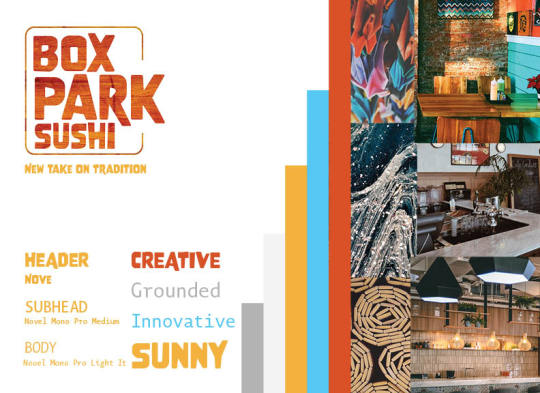
vimeo
Problem Solving
Not a whole lot of problem-solving going on this month. A lot of this felt like a review for myself personally. This month was crazy so the biggest problem that had to be solved was time management.
Innovative Thinking
Finding a differentiation in Box Park Sushi was really challenging. The difficulty was expressing it. Visually it was easy to envision, but putting it down on paper seemed more difficult than expected. Getting feedback from the instructor helped the branding effort and finding the voice and tone much easier.
Acquiring Competencies
This month was all about discovering a brand’s tone and voice and then showing that tone and voice visually in a vision board. Learning about the differences between tone and voice will carry on into Occupational and Conceptual. Learning about storytelling and the process and research done to find compelling stories within a brand falls into Occupational and Conceptual. Giving critiques and knowing how to give and receive critiques is very important in the creative industry. This falls into Occupational, Academic.
Reflection
Overall I felt this month was good but hectic from a personal standpoint. There has been a big improvement in the way the branding is coming along for the Box Park Sushi rebrand, especially from where things ended in the previous course. The area that was really eye-opening and offered a lot of insight was finding out the differences between tone and voice along with the differences between marketing strategy and advertising strategy. Even though I have done a lot of critiques, I found it challenging doing critiques to classmates over an online session. Not only was it challenging to get everyone on the same page in terms of getting the correct software to record the meeting. It was difficult to get things started. It got easier as the conversation went on, but after listening to the recording, It felt like at times I could not communicate what I was trying to say. The static board for Box Park Sushi came out better than expected. I mentioned to Noah who critiqued my static board, that designers can get tunnel vision when designing. That is what I did and missed some composition issues that affected the movement of the viewer's eyes. Thanks to Noah’s feedback I recognized and agreed on the issue and made the appropriate changes. The dynamic board also came out better than expected, especially when using stock imagery, footage, and music. The dynamic board feels like it is an extension of the static board and shows off the tone and voice of Box Park Sushi’s Rebrand well. The critique session for the dynamic board went well, though I think if another motion designer critiqued my dynamic board, they would find more issues. This month was good and seeing how the Box Park Sushi rebrand has progressed from last month to this month is exciting. There are still a lot of changes and tightening in area’s of this rebrand and those will continue on into next month.
Felton, G (2013) Advertising: Concept and Copy 3rd Edition [Online Book] Retrieved from Vital Source Bookshelf
Kenney, J (2017, November 01) Know the Difference Between Tone and Voice to Set Your Brand Apart [Online Article] Retrieved from https://gimmemojo.com/2017/11/01/tone-voice-set-your-brand-apart/
Schmid, S (2013, October 14) Smart, Effective Strategies To Design Marketing Campaigns [Online Article] Retrieved from https://www.smashingmagazine.com/2013/10/strategies-design-marketing-campaigns/
0 notes
Text
DESIGN STRATEGIES AND MOTIVATION
Connecting/Synthesizing/Transforming
The research conducted this month was to discover what research and strategies are needed to produce a design strategy that will sell the benefits and features of a client's product to the intended consumer. These features and benefits must differentiate themselves from the competition, failure to differentiate, will only produce a design strategy that is too broad and will get lost in the crowd of similar strategies. Vlad Margulis says that design strategy is a part of the product strategy and that it focuses on the consumer, what their goals, needs, and pain points are (Margulis, para 7). To develop a design strategy, chapter one of George Felton's book talks about three parts needed for a good strategy. The product, consumer, and the marketplace are the three main parts, and address questions like, Does the product solve a specific problem? Who is the consumer? What is your target audience, and why? How does the product or brand fit into the marketplace, and who is your competition? Answering these questions can help lay the foundation for a successful design strategy.
A designer also needs to know everything about the client, the product, consumer, and the competition. Research is an integral part of a design strategy. Marketers can use demographics and psychographics to help determine who their target audience is, and what needs their product will solve for the consumer. Demographics is research that represents the physical attributes of the target consumer. Like their gender, location, and employment, whereas the psychographics represents the attitudes and opinions of the target consumer. Felton explains it best by saying that demographics represent the outside of a person, and psychographics represents the inside of a person (Felton, p.34).
When the designer knows the client, its product, and who the consumer is. Then two strategic approaches may be used to sell the product to the targeted consumer. The Product-Oriented approach focuses on selling the benefits and features of a product to the consumer by Generic Claim, Positioning, Unique Selling Proposition, and Product Features. This strategy targets the consumer's rational needs. George Felton suggests that the product-oriented approach is better suited for established brands that have a good piece of the market (Felton, p. 46).
The other approach is the Consumer-Oriented approach, which focuses on the emotional needs of the consumer. This strategy is also used to establish a brand's image, voice, and messaging. David Ogilvy says, "Image means personality. Products, like people, have personalities, and they can make or break them in the market place" (Felton, 2013). Using the consumer-oriented strategic approach will help a brand differentiate from the competition and help sell their brand's voice, messaging, and personality to the target consumer. Brand Image, Life Style, and Attitude are all strategies that target the consumer's emotional needs rather than their rationale needs.
Once a designer knows the in's and out's of the product, consumer, and the marketplace. The designer can use all this information to develop a creative brief. The creative brief needs to be precise and focused on the benefits and features that are going to be advertised to the target consumer. The designer wants to focus on the features and benefits that will differentiate the product from its competition. Being too broad or trying to sell to everyone rather than a focused target consumer will fail to differentiate from its competitors.
BoxPark Sushi: Creative Brief
Client Name: BoxPark Sushi
Business Type: Restaurant
What benefits are being promised? Relaxed dining experience.
To whom is it being promised? Men and Women ages 20-45 who enjoy eating sushi relaxed environment.
Why should they believe you? BoxPark Sushi is located in the Box Park mall, which has a modern and casual vibe and atmosphere.
Expanded Categories
Key Insight: Eating sushi in a relaxed casual environment.
Advertising Problem: Newly established restaurant needs to communicate to target consumer that they are open for business and offer a new way to experience sushi.
Advertising Objective: Get more customers in the doors and enjoying sushi.
Target Consumer: Men and Women, 20 to 35 who are sushi lovers.
Competition: Kyoto, Screaming Tuna, and Rice N Roll Bistro
Key Consumer Benefit: Fresh, High-Quality Sushi in a fun and relaxed environment.
Support: Restaurant is in the Box Park mall where it is supported by other modern and creative businesses.
Good Enemy Model
Up Against: Target customers not knowing about BoxPark Sushi.
Stands for: High-quality sushi in a modern and fun atmosphere.
Expression: Modern, creative restaurant.
Demographics
Gender: Male/Female
Age: 20-45 (Average age for East Side is 39)
Location: East Side Milwaukee
Mobility: Car, Public transportation, Uber, Walk or Bike
Income: Average income is $56K
Expenditures: Spends money, likes to dine out and socialize.
Occupation: White-collar workers and College students
Education: Students or graduates with 2 or 4-year degrees
Nationality: Caucasian and Asian
Religion: NA
Marital Status: Single/Dating
Family Status: Single
Psychographics
Attitudes: Generally positive attitude, loves life and works hard to achieve goals.
Opinions: Stays true to what they believe or think, but also values and respects the opinion of others.
Habits: Loves the outdoors and traveling. Seeks new adventures and exercises regularly.
Personality: Kind personality, and gets along with others. Enjoys meeting new people and socializing.
Lifestyle: Enjoys the outdoors and modern conveniences. Eats relatively healthy but not a health nut. Enjoys having a good time with friends and family.
Hobbies: Loves to travel, and doing outdoor activities like hiking, mountain biking, and fishing.
Maslow’s Hierarchy of Needs
What is the highest level possible achieved? Physiological Need
Through what features (or features)? Relaxed Environment
Settle & Alreck’s Shopping List of Needs
What need (or needs) is being met? Consistency Need, Nurturance Need, and Affiliation Need.
Through what feature or (features)? High-quality Sushi, Relaxed Environment
Product-Oriented Strategies
Generic Claim: Fresh, high-quality sushi in a relaxed atmosphere.
Product Features: High-quality sushi, fresh, great customer service.
USP: Located in the modern and creative BoxPark Mall.
Positioning: A modern and relaxed approach to sushi dining. Customer-Oriented Strategies
Brand Image (Personality Traits): Modern, Fresh, Relaxed
Lifestyle: Adventurous, Creative
Attitude: Confident, Fun
Inspiration Examples:

Fig.1 (El Luchador Interior Design by hcreates)
This image is an example of a possible restaurant layout and tactile materials used.
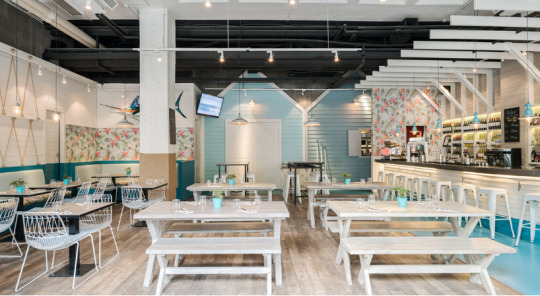
Fig.2 (Designer Hannah Churchill, Photographer Seth Powers)
This image is the inspiration for not only the layout of the restaurant space but also the bright lighting and relaxed atmosphere it produces. Based on research conducted, a lot of sushi restaurants have a dim lighting setup which sets the mood. By brightening up space, a more relaxed and open dining experience can be delivered.

Fig.3 Image Retrieved from https://www.pinterest.com/pin/672654894325635273/
This image is an example of the type of industrial styling of the BoxPark Sushi interior.

Fig.4 Designed by Lazaro Rosa Violan
Another example of how the look and feel of the BoxPark Sushi restaurant can provide a possible relaxed and casual dining experience.
Problem Solving
This month the problem that needed to be solved was which benefits and features were going to be sold to the targeted consumer for BoxPark Sushi restaurant. This was more difficult than expected and required a lot more creative thinking. Looking at the concepts and strategies in the learning, made sense and seemed like a pretty easy task. That was not the case when the designer is actually doing the research and work trying to find benefits and features that will truly differentiate themselves from the competition. The first attempt at the Creative Brief assignment was a failure on the designer's part. The benefits and features listed in the brief were way too broad and did not claim benefits or features that the competition could not claim themselves. More thought and creativity will need to be conducted to truly find the differentiating factors that will set BoxPark Sushi apart from the competition. The creative brief has been slightly adjusted to focus on the benefit and feature of “A Relaxed Dining Experience”. Typically Sushi restaurants interior spaces have a moodier lighting setup, which gives the appearance of a fancy atmosphere. To help with the “relaxing atmosphere” the restaurant will adopt a more open space with more brighter lighting setup. We want the customers who come to BoxPark Sushi to feel relaxed and not feel that they have to dress up or only eat sushi on special occasions.
Innovative Thinking
There was a lack of innovative thinking this month, and the work produced this month was not up to par against other designers in the industry. More work done on the research side is needed to narrow the features and benefits to something that can be offered to the target consumer that BoxPark Sushi competitors do not offer or can not claim. The concept of “A relaxing dining experience” may still be too broad and more research and creative thinking will need to be conducted to find a design strategy that will set BoxPark Sushi apart from the competition.
Acquiring Competencies
This month the competencies that were acquired were concepts of design strategies that if used together can help produce a design strategy that will differentiate the client's features and benefits from the competitions. The most important thing for a designer to know is the product, consumer and the marketplace. Without knowing these inside and out, a designer will not be successful in developing the appropriate strategy. Once the product, consumer and market place is known and research is done (demographics and psychographics) then the appropriate strategy to use should be more clear. A product-oriented approach or a consumer-oriented approach can be used, but these approaches do not necessarily have to be used or parts of each approach can be used. It all depends on what benefits and features of the product is being sold. All the learning acquired this month would fall into the Conceptual and Occupational competency categories.
Reflection
Overall this month has been great. This month has furthered the knowledge learned from past months and showed how these concepts could work together to create a design strategy that can differentiate the benefits and features of a product from the competition. Based on the knowledge and learning objectives, there has been a discovery that the concepts learned are kind of like individual steps in the design process. Coming up with a design strategy that has differentiating factors can be a hard task. The first step would be to research and understand the client, product, consumer, and competition. The second step would be to know what problem is the product truly solving for the consumer. Once a designer knows this information, then the next step for the designer will be the discovery of the product's benefits and features and what basic and higher level of needs are being solved. The designer can then decide which design approach would be better to communicate with the target consumer. Will it be a product-oriented approach or a consumer-oriented approach. Then the designer can further look into the buying behaviors of the target consumer and discover what will help differentiate the benefits and features of the client's product or service. The buying behaviors seem to be the extra detail needed to drive home the differentiating factor. Based on the knowledge gained this month, this is the overall design strategy process and order that these concepts are applied. There are probably multiple approaches to use these concepts at different stages in the design strategy process. Still, the order of the concepts and strategies listed above seem to be the most logical approach based on a subjective opinion.
The understanding of these concepts can be easier than the task itself. Finding a feature and benefit for BoxPark Sushi that differentiates them from the competition was harder than first expected. More research is needed, and the scope of the design strategy presented this month was too broad and needed to be narrowed down. Narrowing the features and benefits down to just one main benefit can help the designer discover a differentiating factor that will help sell the client's product to the targeted consumer. More research on BoxPark Sushi's competitors will also need to be conducted to find out what similarities they possess other than the most obvious ones. Continuing this project in the next few classes will be exciting. It will be interesting to see the process of this project go from a not so good creative brief to a more narrowed down creative brief that has a feature or benefit that does offer something different than the competition.
Felton G. (2013) Advertising Concept and Copy 3rd Edition [Online Book] Retrieved from Vital Bookshelf
Jonathan E. Fig.4 (2019) Lazaro Violan [Online Image] Retrieved from https://www.pinterest.com/IndustrialDecorMagazine/
Margulis V. (2017, March 22) Product Strategy Vs. Design Strategy [Online Article] Retrieved from https://medium.com/@vladmargulis/product-strategy-vs-design-strategy-95bb25724bbb
Natalie S. Fig.1 (2019, July 12) El Luchador Interior Design by hcreates [Online Image] Retrieved from https://gritsandgrids.com/2018/07/el-luchador-interior-design-by-hcreates/
Fig.3 (2019) Trendy kitchen design restaurants industrial ideas [Online Image] Retrieved from https://www.pinterest.com/pin/672654894325635273/
Tereza, Fig. 2 (2018) A Tour of The Hook Restaurant in Shanghai [Online Image] Retrieved from https://www.archlovin.com/2018/12/tour-hook-restaurant-shanghai/
0 notes
Text
Motion Design
Connecting/Synthesizing/Transforming
This month was all about motion design and how it fits into the world of media design. The connections made this month are motion design process, design tools, and storytelling.
The design theories, skills, and research conducted in graphic design are carried over to motion design. Like with all other areas of design, research, and the continuation of improving one's skill set is essential to keep up with the rapid growth of motion design tools and software. Brandon Parvin makes the point that if you are not researching every day, and throughout a project, you are not doing enough (Parvini, 2014). To stay relevant as a designer, one must continue to learn, and this includes design theories and new skills. The process of a motion design project has many crucial steps to achieve the vision or concept successfully, from concept and mood boards to storyboards, animatics to production, and final design. A motion designer needs to know the whole process; in doing so, they can have a better chance at a successful motion design project.

The tools and software used in motion design today are much better for the artist now, then 10 years ago. In the past to be a motion designer you must have a great deal of technical skill to even see your visions come to life. Now things are much different and having those technical skills are not necessary to design for motion, but they still are still very useful to know the technical side of the software used, even if it is a little bit. In an interview with Brandon Paravini and Jeremy Cox, they talk about how artists now can focus on being artistic in these programs and to explore versus just being tied down by application restraints (2014).
Motion design is all about storytelling; without a story, motion design is just moving art that has no voice or message and will fail at capturing the viewer's attention and holding their attention throughout the design. In Eve Claxton's presentation, she talks about how vital storytelling is to get people to buy what you are selling. Whether you are selling an idea or an actual product, humans' attention can be grabbed and held if an intriguing story is involved (Claxton,2013).
Value is one of three elements of a story and is the core of the story's foundation (Huber, 2017). Huber says, value is central to a good story and how value, can make the audience feel inadequate or empowered (Huber, 2017). Value is essentially the brand's voice and messaging to the target audience. An example of a brand's value using empowered would be Nike. Nike's "Just Do It' campaigns empower the audience and make help motivate them and make them feel like they can accomplish their goals. Rolex is a brand that uses inadequacy in the brand's messaging. The audience feels the need to be successful and by having a Rolex watch, they have achieved success in life.

There are three primary career paths or workplaces a motion designer can choose. These are In-House, Agency, and Freelance.
In-house means a designer is working internally for an established brand or company. The designer is focused just on that one brand, and the workplace can often be a more corporate environment. Brianna Flavin discusses the advantages and disadvantages of In-house design work. Advantages of In-house are steady paychecks and careers, the opportunity for advancement, and work is focused on one brand. Disadvantages of in-house design jobs are that you would be limited to brand guidelines, and you would not have as much creative freedom as in other design workplaces. Working with non-creatives or non-designers can make communication hard, and justification will be needed for every design decision(Flavin 2017).
Agency means a designer is working for an agency that works on many brands. Working at an agency is great for new designers. New designers will be working alongside more experienced designers, and the opportunity to learn and find a mentor is greater. According to Flavin (2017), job security is one of the disadvantages of working at an agency. Ed Bebee of Iron Strikes Iron says, "Agencies hire staff to match the contracts they have" (para. 27).
Freelance means a designer works for themselves and has to find their clients and run their business. For new designers, freelance is not advised until a designer has gained experience. Daren Guillory says, "For me, deciding to go freelance was part of the natural progression of my career path. But designers aren't typically thrilled with the prospect of running their own business. In this regard, I am a huge advocate of getting the education (from a reputable design program or university) and experience (from a larger, seasoned design studio) you need prior to going out on your own" (para. 5). Knowing how to run your own business is critical to a successful freelance career.


Problem Solving
Having experience in motion design, the design problem that I choose to work on this month, was to start the process of learning how to animate a character. For a motion graphic designer, added character animation can help reach that next tier of motion design. It adds another level of design and complexity to the designer's work. Here is the process used to begin the journey into learning character animation. The first step was to model and texture a character for animation. Next, the character needs to be rigged for animation. Rigging means adding a bone structure for which the character can be controlled. Once the rigging was complete, I started animating the walk cycle by posing the character. Since this character is a simple stylized character, it only takes a few poses to get the walk cycle completed. The first step is to animate the character moving up and down. The next step is to animate the legs, and then last is the arms. Then you go back through and make adjustments as needed to get the animation looking smooth. Once satisfied with the walk cycle, then you can move onto doing the secondary animations. Examples of this could be the character head moving or the body moving from side to side as the character takes a step. This step can be very complicated, especially if you have a complex character. Character animation can be very daunting, just thinking about it. Once a designer takes the plunge and jumps in, the animation theories and techniques that apply in other areas of motion design apply to character design as well. It takes some time, but if a designer is willing to put in the work, they can be efficient in character animation, and it will help elevate their design work.
youtube
Innovative Thinking
This month, some innovative thinking was needed to figure out what was the best style and type of character to start with when first learning character animation. It was decided to animate a simple and stylized character. This would allow for learning the very basics of character animation while not making it overly complicated on the first attempt. The choice to animate a piece of fruit as a character satisfied these criteria as a beginner. Since my character is a pineapple and not an actual living creature, I had to figure out how to rig the character that has a head for a body. By accomplishing my goal to get a 3D character to walk, and look decent is a way to measure the success of this project. There is still a lot of improvements and skills I need to learn to be a competent character animator. I feel this project was successful because the goal of animating a 3D character was achieved and that it has given me the drive to learn more and to work on being an expert at character animation.
Acquiring Competencies
Working in the motion design industry, a lot of the information presented this month was not new, but was a great refresher. There was still a lot of new information that helped paint the picture of the motion designer in media design. This month, the competencies that were acquired were how important storytelling is to not only design but in motion design. Storytelling falls under conceptual, and technical categories. The process of character animation which includes, creating the character, rigging and animating. Character animation falls into the conceptual, technical and occupational categories. The types of workplaces and career paths a motion designer can pursue were very enlightening. In-house, Agency and Freelance career paths can be categorized into occupational and academic.
Reflection
Overall this month has been great. Working in the motion design industry currently. this month has given me a renewed outlook on motion design and a motivation to learn new skill sets and techniques. This month has reaffirmed the importance of storytelling in motion design and how it can help gain and keep the viewer's attention. If a design does not tell a story, then it is just art that is subjective to the viewer. Capture the viewer's attention in the beginning and continue to keep their attention throughout. Just like in graphic design, use the motion of objects, character, camera movements, to direct the viewer's eyes to progress the story. Use animation principles like anticipation, squash, and stretch, secondary animation, pausing, timing, and follow-through. These techniques will help make the motion feel realistic and help in directing the viewer's eyes. These techniques also help the viewer feel the emotion portrayed in the motion design they are watching. Continuing to be creative and not letting the tools dictate the design is very important in motion design. If we let the tools dictate our designs, then our motion projects will be lacking creativity. There are many career paths a motion designer can pursue. It is advised that new motion designers work in an agency before going to work for a in-house design group or going the freelance route. Working at an agency first allows a new designer to gain valuable experience and to work alongside other designers. This has been a great month of learning how motion design fits into the world of media design.
Claxton E. (2013, October 11) Stories and Art of Persuasion [Video Presentation] Retrieved from https://www.aiga.org/aiga/content/events-and-competitions/aiga-events/head-heart-hand-aiga-design-conference/video-eve-claxton/
Guillory D. (2019) Freelance Considerations: Lessons Learned [Online Article] Retrieved from
https://www.aiga.org/aiga/content/inspiration/member-contributed-articles/freelance-considerations-lessons-learned/
Flavin B. (2017, July 24) Where Do Graphic Designers Work? In-House vs. Agency vs. Freelance [Online Article] Retrieved from https://www.rasmussen.edu/degrees/design/blog/where-do-graphic-designers-work/
Huber, A (2017) Telling the Design Story [Online Book] Retrieved from https://learning.oreilly.com/library/view/telling-the-design/9781351849210/10-9781315226132_chapter-chap1.xhtml#chap1
0 notes
Text
In-House, Freelance, or Agency


This week was about discovering the workplace options for motion designers. Discussed in most of the research In-house, Freelance, and Agency options for designers. In-house is a design or creative group within an established brand or company. Freelance is for designers who want to be their own boss and have the choice of what projects to work on. Basically running your own company, a freelancer has to find their own work and know the ins and outs of running a business. Agency is working at a creative agency that has many clients. The benefits of working at a creative agency is the experience of working with other creatives and gaining valuable experience. Ram Castillo says “ First, you need experience somewhere, anywhere. The best place to build foundations is in idea generation, working quickly with real briefs/live jobs, internal collaboration opportunities, presenting to clients, and understanding how businesses processes work—and that’s best found in an agency”(Castillo, para 2). While these options are viable for all graphic designers, motion designers have another option that was not discussed which is a dedicated motion design or animation studio. These studios solely focus on motion design and or animation and are hired by Agencies and In-House design groups for motion projects.
There are many benefits and disadvantages to which form a design workplace to start a design career. Occupational, Conceptual
In-House design groups are work within an established brand or company. Occupational Conceptual
Learned how to properly use the content-aware fill tool in Photoshop. Technical, Occupational
Castillo R. (2019) In-house, agency, or freelance—what’s right for me? [Online Article] Retrieved from https://www.aiga.org/aiga/content/inspiration/in-house-agency-or-freelancewhats-right-for-me/
0 notes
Text
Storytelling & Motion

This week was all about storytelling and using motion to give life to the story. Just like reading a really good story in a book, a person can start to imagine the characters and settings. Motion design does the same, but now the viewer can see the story play out visually. Motion design can grab the viewer’s attention and keep their attention until the conclusion. Without a story, motion design is just moving graphics with no purpose and it will fail to even draw the attention of the intended audience. Karin Fong is a motion designer for Imaginary Forces. She says “ Opening titles are an invitation. Good ones Stir feeling of anticipation, making it easy for the viewer to join in” (Fong, para 2).
Storytelling is essential to motion design. Occupational, Conceptual
Learned about other designer's processes and how they go about telling story’s in their design projects. Occupational, Technical
Obstacles to creative thinking like mental block, overuse of stylistic trends, premade digital effects and minimal artistic skills. Occupational, Conceptual
Understanding the restrictions of a creative design project. Examples are budget, assets, tools and time. Conceptual, Occupational.
Fong, K ( 2018, March 20) Karin Fong [Article, Interview] Retrieved from https://www.aiga.org/aiga/content/inspiration/aiga-medalist/medalist-karin-fong/
0 notes
Text
Motion Design

This week was exciting because motion design is what I do as an occupation. Learning about the history of animation and motion design definitely gave me new insights and appreciation for the technology we have today. Though most of the information this week is not new to me. It is always good to get a refresher on the animation theories and concepts. Reading the assigned chapters from Jon Krasner’s book was definitely enlightening, especially when he talks about motion design in public spaces. He says “ The potential of motion graphics in our physical world has fnally been realized and is helping to shape the landscape of environmental interior and exterior design. Public informational systems, performance art, memorial and donor recognition programs, and contemporary video installations are vehicles that have opened new doors for motion graphic designers” (Kresner, para 1 ). Working in the industry now, as a commercial artist, it was unknown to me how much potential motion has outside the traditional forms of mediums.
The processes used in other areas of design is carried over into motion design. Occupational, Conceptual
Learned about infographic applications. Academic, Technical
Learned about animation concepts and how to use them in motion design. Occupational, Technical
Learned about the history of animation and motion design. Academic, Conceptual, Occupational
Motion design opportunities in outdoor spaces. Occupational, Technical.
Krashner J. (2013) Motion Graphic Designer, (3rd Ed.) [Book] Retrieved from https://learning.oreilly.com/library/view/motion-graphic-design/9780240821139/014_9780240824703_chapter5.html
0 notes
Text
Place Branding
Connecting/Synthesizing/Transforming
The research conducted this month was to find out more about the location/place that was chosen to brand, which is Main St. located in Rathdrum, Idaho. The research conducted was to uncover unique factors about this location and what possible differentiations it might have compared to the competition. During this course, three overall connections were made that represent the process of place branding. During the month, a few connections were made in terms of the place branding process. Julian Stubbs talks about the three elements of great place branding. The first is a long-term focus. Julian says that the goals of the branding should have definable long term strategic objectives. Second is distinct positioning, which means that the brand has to stand out from the competitions. The third is communication that really communicates. Using clear communication and attracting the right customer to seek out information on the brand (Stubbs 2016).
Marty Neumeier says, "When everybody zigs, zag"(Neumeier,2007). Finding out what makes the location/place being branded differently from areas that are in direct competition with it is very important for successful place branding. Without differentiation, the brand will be lost in a crowd of brands doing the same thing. The third connection is research, and Tori Mckinley discusses the immersive phase and discovery phase, and how these research practices help to better understand the client's brand and their needs (Mckinley, 2016). Digging deeper into the research and discovering positive and unique factors for the brand's location and its competitors can help lead to the discovery of differentiation. All three of these connections support one another, and great place branding does not exist without all three. Research is the keystone to it all. The basis of place branding starts with researching the client, what their brand is about, and what is the design problem. Once the overall goals are identified, then research will also be needed on the brand's competitors. More research is needed to discover unique factors and qualities that will differentiate the brand from competitors. The whole process of place branding is research.
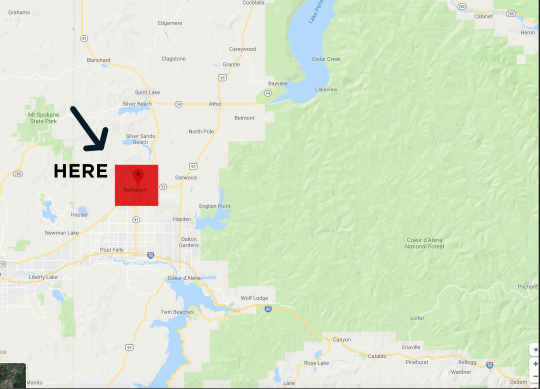
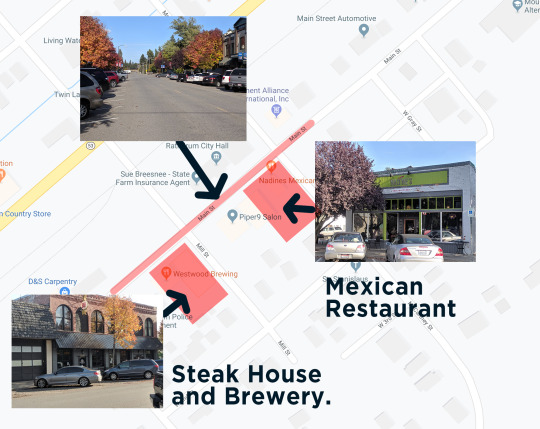
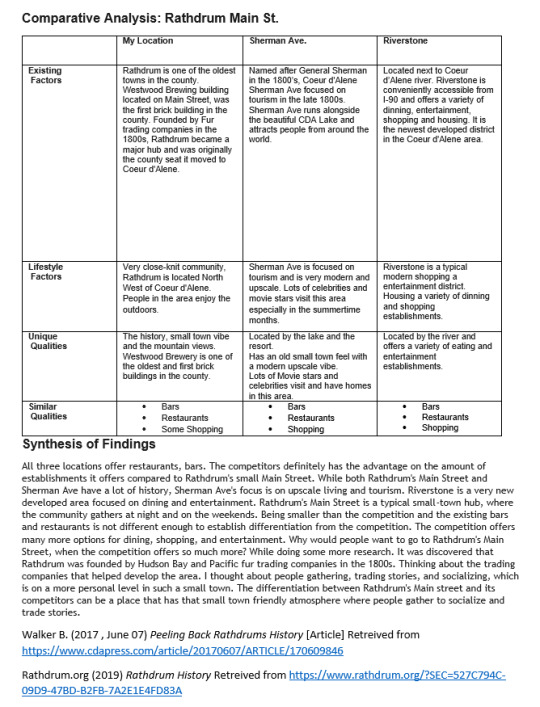
Problem Solving
This month was mostly research, so the only real design problem that pertained to the place branding was the interview questions. Not ever conducted interviews before. It was decided that instead of recording the interview and having to go through the recordings, it would be more comfortable and more efficient to use the laptop and record the answers as they were given. It seemed that this technique made the people interviewed more at ease and willing to talk. During the interview, questions could be added based on the answers given.
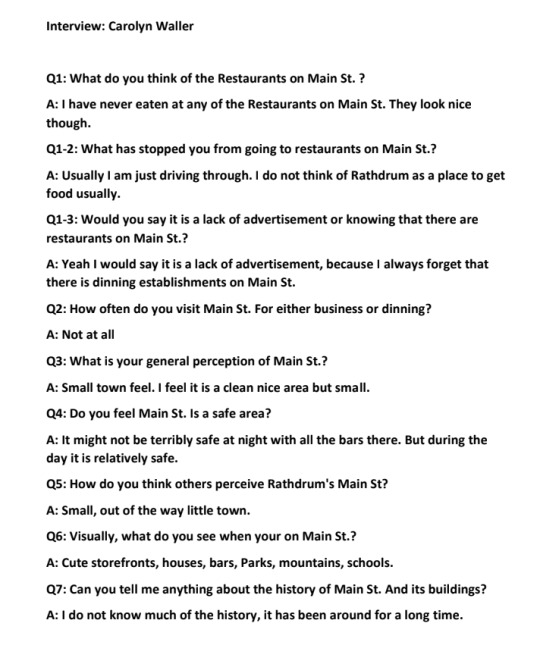
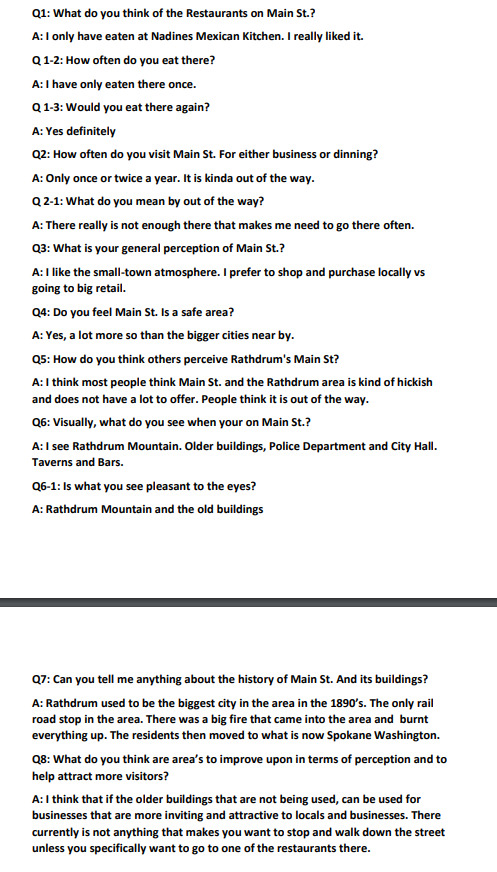
Innovative Thinking
Having done research before, this is the first time doing this amount of in-depth research in a short period. Place branding is also new to me, so the whole process was very enlightening. My work this month compared to the work and research a company does is barely scratching the surface of how much research is needed to find unique qualities and factors that make a brand different from the competition. The research conducted this month did have some interesting findings that could lead to differentiation if more research is conducted.
Acquiring Competencies
For someone who currently works in the media design industry, there were tons of new information and takeaways from this month. Place branding is creating a brand for a specific area of town or district to attract potential customers, home buyers, businesses, and people seeking recreation. Determining the personality and lifestyle of the area and the people within the branded area. For place branding to be successful, it is essential to find the unique qualities and factors that make the place/location different from the competition. Narrowing down the factors that make the location's brand differentiate from the competition. General facts are not enough to find the differentiation between the brand's location and its competition. Discovering the history and stories of a place/location can help in the discovery of unique and exciting factors to consider for differentiation. Innovative thinking also falls into the differentiation category. In Bryan Collins's article, he discusses three strategies for innovative thinking. The strategies are, seek out inspiration, combine similar ideas, and solve a problem (Collins,2018 ). Using interviews as primary research is a great way to find out what people think about the brand. This month has been very eye-opening on how hard and how much work goes into place branding.
Reflection
This month seemed like it was just going to be the same as just branding a product. The takeaways from this month are that place branding is difficult, especially finding the differentiation factors that differ from the competition. The research was in-depth, more so than I ever have done on any branding campaign. This knowledge will help with future classes in this course and my career
References:
Collins B (2018, June 25) 3 Strategies For Developing Innovative Thinking [Article] Retrieved from https://www.forbes.com/sites/bryancollinseurope/2018/06/25/innovative-thinking/#62975b3a7b88
Stubbs, J (2016, February 26) Three elements of great place branding [Web Article] Retrieved from https://www.upthereeverywhere.com/blog/three-elements-of-great-place-branding
Mckinley, T (2016, 4 May) frog Design's Turi McKinley on Problem Solving and Design Research: GLG Leading Learners [Video] Retrieved from https://www.youtube.com/watch?time_continue=24&v=h2jBP3oOJZM
Neumeir, M (2007) ZAG The Number-One Strategy of High-Performance Brands. [Safari Book] Retrieved from https://ce.safaribooksonline.com/0321426770/xi
0 notes
Text
Effective Copywriting Reflection
This month was very insightful for me. For someone who works in motion graphics and video, the copy has always been an afterthought. I have always known that copy is important, but since someone else always does it, I never really thought about how copy is the voice of the brand.
Reading George Felton's book Advertising: Concept & Copy has been very insightful. Felton says “Until you discover the real reasons that people buy this or that good or service, or identify with this brand instead of that brand, you create ads for no one”(p.8). It has helped me see the whole picture of a product's brand messaging and its voice and how to write copy the reflects that voice.
I really enjoyed the section about customer needs, and how Felton talks about Maslows hierarchy of needs. He talks about how to reach a consumer higher level of needs, you must satisfy the consumer's lower levels of needs first (Felton, p22). This really made me think more about products and how the product meets consumer needs in more ways than the product itself.

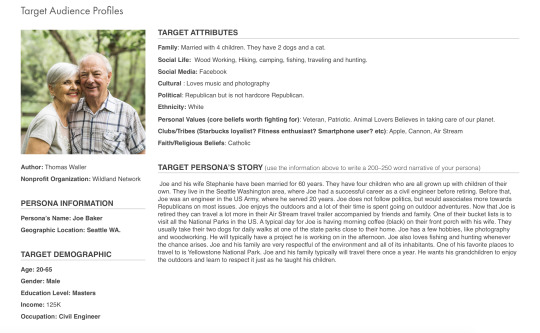
Researching Wildlands Network and what its mission is, I was able to develop the target audience profiles to help create the brand’s voice and messaging. Felton talks about becoming the consumer and how your ad messaging should not address the consumer but should speak to the consumer in a way that represents themselves (p.105).
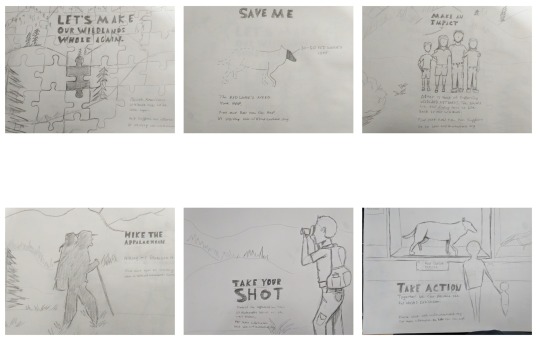
My strategy for the ad sketches was to explore the non-profit and because they have multiple campaigns currently going on, I focused these concept sketches on 3 of those campaigns. Craig Smallish talks about the core values of a product and how those values and beliefs can be related to the consumer (Smallish, 2013). I used the research conducted on the organization and applied their voice and core values into the concept sketches that will relate to the target audience.
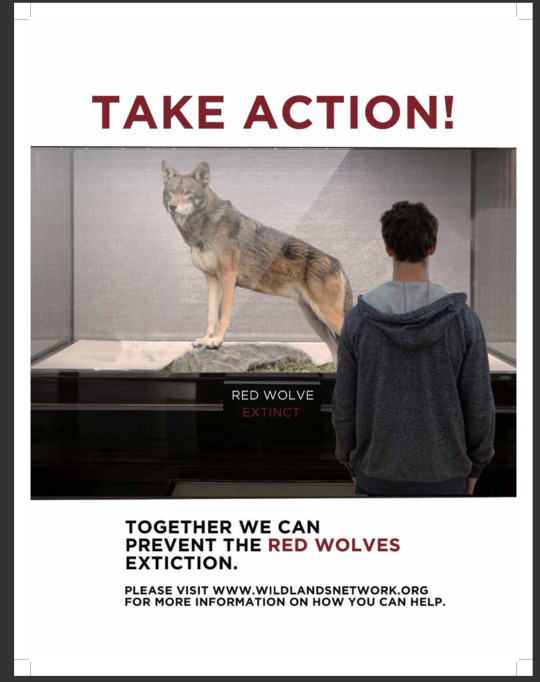
This concept is focusing on the campaign to save the Red Wolve’s from extinction. The message is sort of a warning. If we do not take action now then this animal will no longer be around. Craig Smallish talks about the importance of font selection and how the type can help attract attention (Smallish, 2013). I wanted to bring attention to the headline “Take Action” to help draw the viewer in and raise interest.

This concept is focused on the Wildlands Network campaign to heal the lands surrounding the Appalachian trails. Since the campaign is about healing and restoring these ecosystems, the concept is to show a puzzle of this beautiful landscape with puzzle pieces missing.
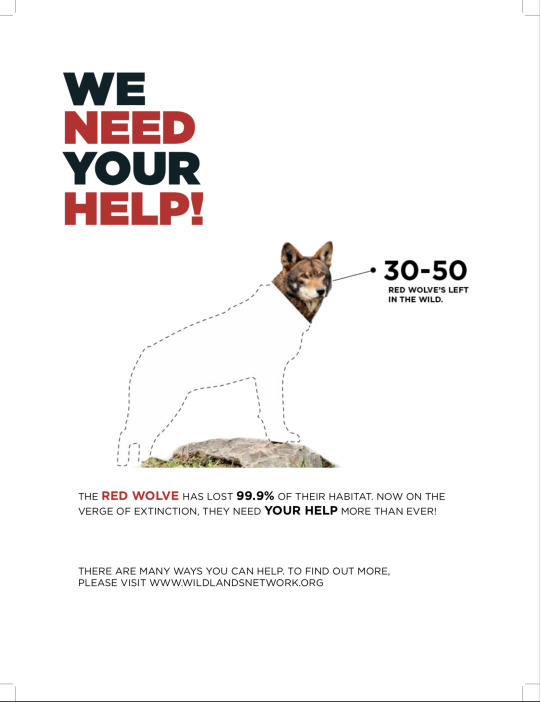
This is another concept for save the Red Wolve’s campaign. Using type and a graphic on a white background to create a dramatic effect. Craig Smallish states that contrast used right, can help direct the viewers eyes along with making elements dominate over others, creating heirarchy (Smallish, 2013).
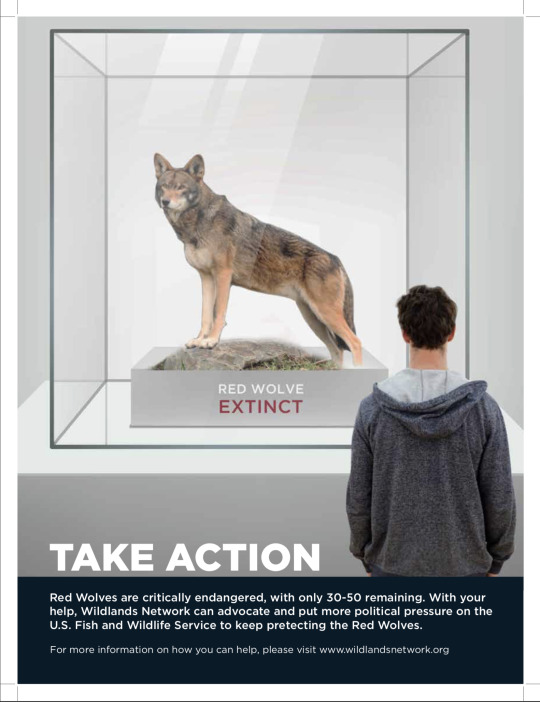
After receiving feedback, I reworked the image to make it go full screen. I also wanted the visual of the Red Wolf in the display to be the hero and then the headline to follow.
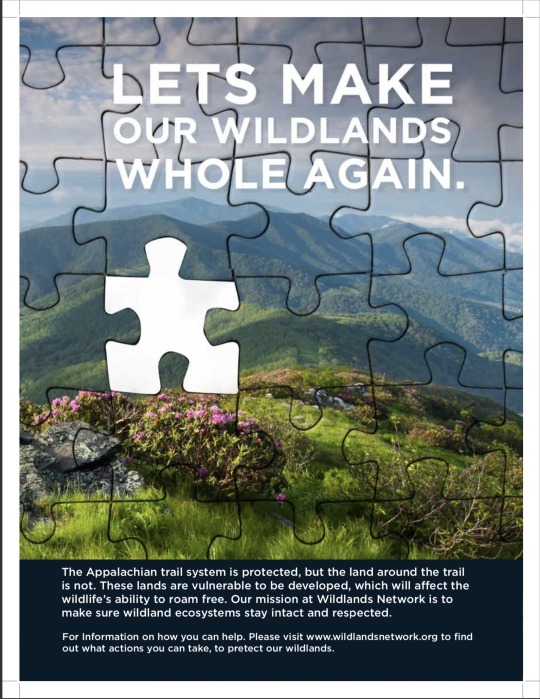
For this revision, I made the type more dominant and readable. I removed the missing pieces in the bottom right corner because it was distracting from the other elements. The viewer see the headline then their eyes move to the missing puzzle piece and then down to the body copy.

This revision I moved the type to the bottom. I made the graphic larger for a more dramatic effect. The graphic is the hero followed by the type. The contrast helps make the graphic pop.
My takeaways from this course are to really get to know the client and their product. Know the target audience and how why they like the brand and what needs the product fulfills. Knowing the brand's voice and tone can help communicate that message to the target audience.
References
Felton, G. (2013). Advertising: concept and copy(3rd ed.). [PDF Version] Retrieved from https://online.fullsail.edu/class_sections/46769/modules/177929/activities/1113172
Smallish C. (2013) Developing Ideas and Advertising Concepts [Online Course] Retrieved from https://www.lynda.com/Design-Business-tutorials/Using-storytelling-determine-core-values/126121/145393-4.html?srchtrk=index%3a3%0alinktypeid%3a2%
0 notes
Text
Client Relations Mastery Journal
This month in Client Relations taught me a lot about working with clients and how to utilize the design process to help understand the client’s brand. I also learned a lot of lessons on designing in general. The typography lessons by Ina Saltz were excellent, along with the design layout lessons by Sean Adams. I will definitely be using what I learned this month by implementing them into my own design process.
Researching how Margo Chase tackled the re-brand for Chinese Laundry was a big eye opener for me. Their intensive research conducted prior to any designing is what made the re-brand so successful. They were able to understand their client and the client’s customers through this research. The Chase Group used a six step process which consisted of research, psychographic mapping, persona development, emotional targeting, visual brand stories, and design (Chase 2008). I learned that research is an essential part in the design process and it should never be overlooked. It is also equally important to listen to your client, to understand their needs and wants, and to keep an open mind. As Marty Neumeier says “When the left brain and right brain work together, a third brain emerges that can do what neither brain can do alone” (Neumeier 2009).
Simon Sinek talked about the three questions a designer should ask their client. Who are you? What do you do? Why does it matter? Simon calls these questions the “Golden Circle”. “Why” being at the center and the most important. When he talked about companies like Apple who uses the golden circle to differentiate themselves from their competition (Sinek 2010). It made me think about how we as designers can utilize these questions to help clients communicate and differentiate their brands identity, belief, and message, from the competition. I can now see how companies like Apple, truly do stand out and differentiate themselves from the competition. Marty Neumeier says “As we’ve moved from a one-size-fits-all economy to a mass-customization economy, the attention of marketing has shifted from features, to benefits, to experience, to tribal identification. In other words, selling has evolved from an emphasis on “what it has,” to “what it does,” to “what you’ll feel,” to “who you are.” This shift demonstrates that, while features and benefits are still important to people, personal identity has become even more important” (Neumeier 2006).
I have always known typography was important, but I never really had an in depth learning experience about typography that this class provided. The typography video by Ina Saltz was excellent, and provided a lot of knowledge about how to properly use typography to communicate effectively. Ina emphasized the importance of hierarchy, position, size, weight, color, contrast, and orientation to create compelling and effective typography (Saltz 2013).
Sean Adams tutorial on Foundations of Layout and Composition was excellent. The lesson taught me more about hierarchy, color, balance and tension, contrast, harmony, scale and repetition (Adams 2013). The real discovery for me was the use of the Golden Section. I heard of the Golden Section before but I just never really knew how to use it. Adams explanation of the golden circle and how it is found throughout nature, and to use it as a guide and not as a rule was very helpful. I know feel more confident that I can use the golden section with my own designs in the future.
What I have learned in Client Relations, will help me interact with clients, and to use research to help understand the clients brand and their brands message to their customers. I will also use the design skills and concepts to help create compelling designs, which effectively communicates the message of a brand or design.

Reference
Adams, S. (2013, October 31). Redirecting to Full Sail University. Retrieved November 21, 2015, from http://www.lynda.com/Design-tutorials/Foundations-Layout-Composition/135095-2.html?org=fullsail.edu
Chase, M. (2008, September 4). Branding from the Course Creative Inspirations: Margo Chase, Graphic Designer. Retrieved October 28, 2015, from http://www.lynda.com/Design-Documentaries-tutorials/Branding/685/38838-4.html
Neumeier, M. (2006). The brand gap: How to bridge the distance between business strategy and design : A whiteboard overview (Rev. ed.). Berkekley, CA: New Riders.
Neumeier, M. (2009). The designful company: How to build a culture of nonstop innovation : A whiteboard overview. Berkeley, CA: New Riders.
Saltz, I. (2013, November 25). Creating hierarchy using position from the Course Foundations of Typography: Hierarchy and Navigation. Retrieved November 21, 2015, from http://www.lynda.com/Design-Typography-tutorials/Creating-hierarchy-using-position/133327/156591-4.html
Sinek, S. (2010, May 4). Simon Sinek: How great leaders inspire action. Retrieved November 4, 2015, from https://www.youtube.com/watch?v=qp0HIF3SfI4
0 notes
Video
0 notes
Photo
Nice Job!!



















Week04: Mastery Journal Timeline goals
2 notes
·
View notes